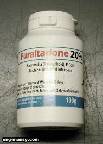
Mode of Action
Sulfonamides are bacteriostatic, although a bactericidal action is evident at the high concentrations that may be found in urine.
The sulfonamides are structural analogs of para-aminobenzoic acid (PABA) and competitively inhibit dihydropterate synthetase, an enzyme that facilitates PABA as a substrate for the synthesis of dihydrofolic acid (folic acid).
Dihydrofolate is a precursor for formation of tetrahydrofolate (folinic acid), an essential component of the coenzymes responsible for single carbon metabolism in cells.
Sulfonamides are antimetabolites that substitute for PABA, resulting in blockade of several enzymes needed for the biogenesis of purine bases and inhibition of growth and replication occur in organisms that cannot use preformed (eg, dietary) folate. Sulfonamides are most effective in the early stages of acute infections when organisms are rapidly multiplying. They are not active against quiescent bacteria.
The efficacy of sulfonamides can be reduced radically by excess PABA, folic acid, thymine, purine, methionine, plasma, blood, albumin, tissue autolysates, and endogenous protein-degradation products.



